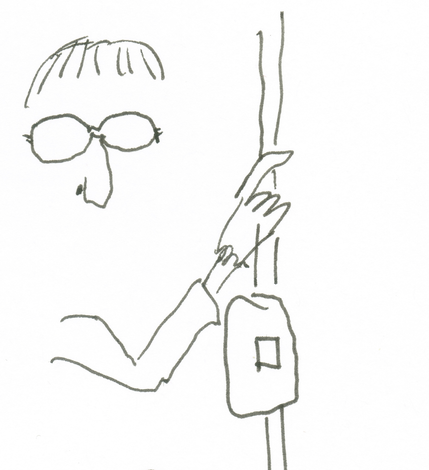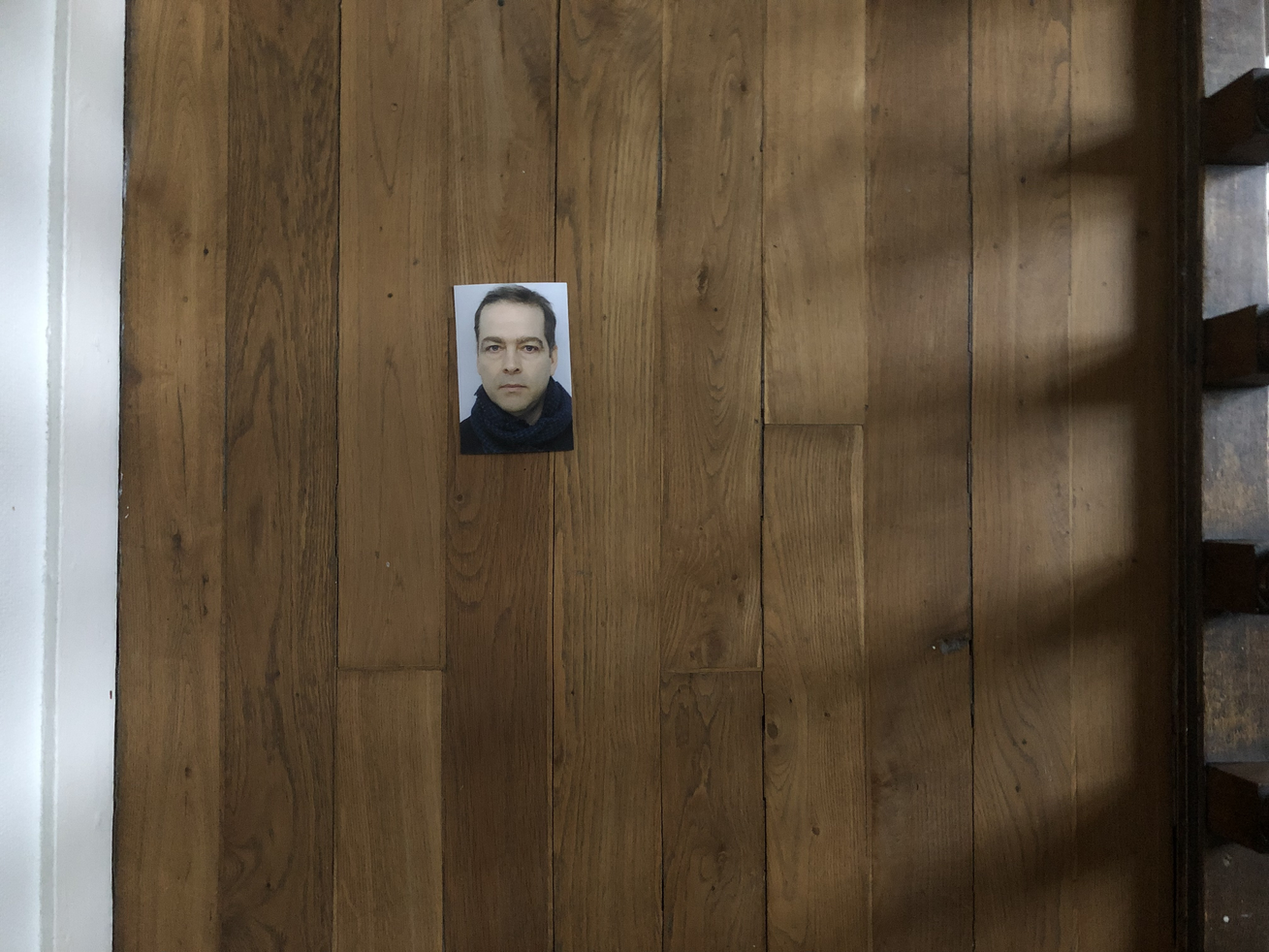Passport photo taken in Enghien-les-Bains, Paris, France, on the 20.12.2021, the day of handing in the Ph.d.
LIST OF WORKS
Aftenrøde (Evening Red) (8’) Trio with found sound (from an uncredited self-help cassette found in a flea market), for the trio Poing: Alto sax, accordion and double bass
Fast Food for Slow People (10’) Instrumental composition for quartet, with electro-acoustic voice imitation, and a look at the genre of the program text, for Tøyen Fil og Klafferi
The Transformations (dur.?) Drama in one act for three performers, not yet performed (and no music composed so far), only in manuscript, work in progress. But with music cues written in, for the reader to imagine
On Location (11’) Audio only fixed-media electroacoustic composition with the voice of Bonnie Whiting. Also performed live as work in progress with Eirik Krokfjord (narration) and 4-channel sound
A Letter from Petter (29’) Live radio play for percussion trio Torrence/Whiting/Hills
Sixty-Forty (31’) Music theatre piece for percussion trio Pinquins, on the subject music and health
Lambert, Lambert! (32’) Contemporary chamber opera for three voices and electro-acoustic music, for Natali Abrahamsen Garner, Ditte Marie Bræin and Halvor Festervoll Melien
ACKNOWLEDGEMENTS
I sincerely would like to thank all the performers who all have given their very best and made the works come to life. Without you, none of this would have been possible. Thank you:
Poing: Frode Haltli, Rolf-Erik Nystrøm and Håkon Thelin
Tøyen Fil og Klafferi: Hanne Rekdal, Kristine Tjøgersen, Eira B. Foss and Tove M. Erikstad
Eirik Krokfjord who premiered On Location
The team in A Letter from Petter: Bonnie Whiting, Jennifer Torrence and Cory Hills
Bonnie Whiting and Kristine Tjøgersen for the second and final fixed-media version of On Location
Pinquins: Ane Marthe Sørlien Holen, Sigrun Rogstad Gomnæs and Jennifer Torrence
The team in Lambert, Lambert: Natali Abrahamsen Garner, Ditte Marie Bræin and Halvor Festervoll Melien
Also a big thank you to my theatre helpers: Håkon Vassvik, who directed and helped with acting training in Sixty-Forty, and Tormod Lindgren for scenography and directing Lambert, Lambert!
I also want to thank my supervisors, who have been with me at various stages of the project period: Manos Tsangaris, Gaea Schoeters, Henrik Hellstenius, and a special thank you to my main supervisor Darla Crispin for invaluable assistance during the final stage of the artistic reflection (plus so much more).
And a very big thank you to Merete Morken Andersen who has taught me so much.
From the Academy I would like to thank Ellen Ugelvik and Birgitte Grydeland Pollen for all help with everything, plus my fellow colleagues Josh Spear, Andrea Parkins, Andreas Borregaard and Karin Hellqvist, plus Bjørn Erik Haugen, Simon Løffler, Liv Kristin Holmberg and Sanae Yoshida, for the good and valuable discussions and social contact.
Thank you Carola Bauckholt, for all the input and the good conversations.
Last and very most: Thank you Kristine Tjøgersen, for never-ending support, design-genius for this exposition, and believing in me and all the projects.
SUMMARY
The three-year period of artistic research has been a very fruitful and intense time. It has given me unique opportunities to try out different kinds of ideas and concepts concerning how text and sound work together on the music theatre stage.
I have made seven pieces (see List of Works below), and in the reporting and reflecting within this exposition, it was not possible to log every single step toward their evolution. But I do have a hope that some of the experiences shared are ones with which others may identify, finding inspiration or support for their own projects, and perhaps being supported to find and see possible ideas and solutions themselves. I would be very proud were that to happen, even if it might mean doing the opposite, which is also how art moves forward.
I chose the three keywords Everyday, Collection and Form for this exposition; for future investigations, I can imagine adding Theatre to the list, since the works here ended up on theatre stages, and there are, of course, endless possibilities to explore further under that heading. This may include Opera as well, as a similar overarching concept for meetings of music and theatre. I was thinking a lot about opera when I started out but have become somewhat reserved about using it for my own work, perhaps because I have felt that the pieces are not so opera-like. This is a question of definition, but frankly, I don’t think this matters so much. As I hope has become clear, through the descriptions of my work processes, their concerns and considerations, twists and turns, I never worked with a rigidly pre-set idea of how a piece must turn out (with Sixty-Forty as one possible exception). Instead, I believe that I have discovered the forms, and the relationships between music and words, as the pieces grew and found their shape. I also believe that some of them are quite personal and not so easily labelled.
Something Robert Ashley said in an interview in 2001 may illustrate the dilemma:
I know that my operas do not sound like Puccini. But the idea of telling a rather complicated story over an hour and a half with a lot of characters, and where the telling of the story is based on the musical forms to the same degree that it happens in Puccini, but in a different manner. The problem is that you don’t have any words… I mean, I wish I had a different word, so I didn’t have to use the word opera, because that causes a lot of confusion. It causes people to ask me silly questions, I mean not you [Frank J. Oteri, the interviewer from New Music USA], but people to ask me silly questions like ‘how do you have… what right do you have to call your work opera?’ I say it’s because I don’t have another word. There is no other word that everybody understands for the notion of telling a long story based on musical forms. [1]
THINGS I DID NOT DO
Perhaps unusually in this type of exposition, I have not written a great deal about the collaborations with the performers – not because there is nothing to report, but mainly since this was not a huge focus for me. However, I see that this could be dealt with in later reflection work, especially if we have Theatre as a future theme, as previously mentioned, with the working-together with the performers taking place over longer time periods. All of the pieces were actually produced rather quickly, with two weeks as the maximum length of the rehearsal periods.
I also did not write a song cycle, though it was on the list of initial plans. My texts were not always so easy to sing. For instance, some of the café observations sounded extremely parodic when I tried to sing them out. But I do not exclude that this can be done in the future. If this should happen, it will be a matter of finding a form that makes sense, meaning that it is the best possible way to utter these words. Or maybe it means doing the exact opposite; starting from the music, and seeing which verbal impulses this can give?
A SELF-PORTRAIT
I see this reflection mainly as a self-portrait, describing steps and chains of events in creative processes, considerations along the way that are both aesthetic and ethical, and with my own person at the centre, moving between the themes and keywords that are central concepts in how I think about art and art making, and the things that I aim to achieve. Through this, I am sketching a poetic of my own.
The sympathetic reader will have to search between the lines, since I am so close to what I examine that I cannot claim to always seeing it clearly with my own eyes, and have difficulties saying explicitly “it is this and this”.
I have, therefore, been avoiding too much interpretation and telling the reader and audience member “this is what it all really means”, in order to let the viewers have their own experience and make their own sense. This is not only because I am attracted to ambiguous artworks, but even more since I see this in keeping with how my pieces, to some degree at least, are resistant to severely one-sided interpretations. This idea – which may sound like an apology – is actually an attempt to describe my works, precisely by not saying how they are to be read, since I realize that they may be read in several different ways. One can compare it to how our mirror image differs from day to day, according to how we slept, what goes on right now, what worries us, things to look forward to etc.
I hope to have made it clear that doing this is already a description, by leaving things out, in Mathews’ sense.
IDEAS FOR STORIES
A scientist feels that others are given priority before him. Irritated and annoyed, he takes the bus, staring gloomily out through the window. In the seat next to him he finds a bill for an overalls. He pays it.
Two brothers buy a bag of potato chips. There is a small key inside the bag.
Stokmarknes 1957. A swede comes there and has a child with a woman living there. They move further north, because there it is easier to find work.
Twenty minutes into a football game, one of the players falls and is being carried out on a stretcher. (The ballgame is described by someone who doesn’t really understand what’s going on.) In the dressing room he tells his life story to a guy from the Red Cross.
A messy person is driving quickly past other cars in a Mini Morris. One day he buys a dog.
IDEAS FOR STORIES (CONT.)
A blacksmith is accused of having smashed a beehive, so that all the bees are terrorizing a small village. It turns out that somebody has stolen the blacksmith’s sledgehammer. And the investigation shows that he has an alibi, as he was on honeymoon when the destruction happened.
A young girl finds a mandolin in the forest. There is blood on the mandolin. The girl puts up a note about it in the local grocery store, but the next morning the poster is taken down. The same day somebody breaks into her home to steal the mandolin, but they only get away with a bottle of cough syrup, possibly believing it contains morphine, or so the family reasons. They report the theft, but are not believed.
The next morning, however, the hairdresser in the village wakes up with a blue spot on his leg. Unable to get to work, as he works in a house with a very steep staircase, he receives the customers at home. There he gets to hear that the mandolin belonged to a captain.
A guy installs LED-lights in his ass. He gets attention when he wanders around bare-chested at the annual summer party. Just when he is about to light the lights the main fuse in the house is blown, and he becomes very visible.
Later he marries the daughter of the school master. They sleep together in the attic while her parents are playing with a remote-controlled car in the school yard.
The police officer is on the warpath after somebody has stolen the coffee pot of his secret mistress, Malla. For the last few days, they have drunk only soft drinks and have suffered repeated sugar-rushes.
Somebody who calls themselves “The Little Trolls” have managed to capture and tame a moose. The moose is appointed professor in wild life. Harriet Steinsland, a local news reporter, smells a scoop, and writes an article that is sold to 14 countries. Extra attention is given to her endless discussions about correct spelling and punctuation, choice of words and orthography with the moose, which insists on reading through the article before it is being published.
Arnstein Cough is wearing a t-shirt that says: “I am totally crazy!”
Somebody hides behind a bush and says: “Coo-coo!”
A boy is coughing. His mother buys candy. The cashier has a secret.
An aunt buys a goldfish. She goes on holiday to the Galapagos Islands, and sends a post card to the goldfish.
Somebody has stolen fire wood from somebody called Quantum.
A guy walks around with an unripe apple in his underpants, to see if it ripens faster that way. Every evening he compares it to one that lies in a basket by the gazebo.
A woman refuses to believe that the combination of beer and port wine is also called “green sweater”. She makes a bet. This leads to big changes in her life, as she becomes the sole heiress to a flock of sheep.
Thought experiment: Rename the headline for this to “IDEAS FOR PAINTINGS.”





















